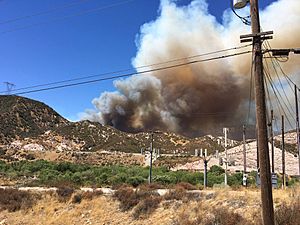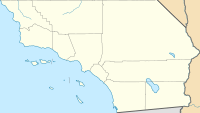Blue Cut Fire facts for kids
The Blue Cut Fire was a large wildfire that happened in San Bernardino County, California, in August 2016. It started near the Cajon Pass, which is a mountain pass in Southern California. The fire began on August 16, 2016, on a hiking trail called Blue Cut.
When the fire started, the weather was very hot, around 100 °F (38 °C) (38°C), and strong winds were blowing up to 30 miles per hour (48 km/h). This made the fire spread very quickly. By August 18, the fire had burned about 37,000 acres (14,973 ha) of land. It also sadly destroyed 105 homes and 213 other buildings.
Quick facts for kids Blue Cut Fire |
|
|---|---|

Smoke rises above the fire on August 17
|
|
| Location | Cajon Pass, San Bernardino County, California |
| Coordinates | 34°16′03″N 117°27′24″W / 34.26763°N 117.456805°W |
| Statistics | |
| Date(s) | August 16, 2016 – August 23, 2016 |
| Burned area | 37,000 acres (14,973 ha) |
| Cause | Under investigation |
| Buildings destroyed |
|
| Map | |
Contents
How the Fire Spread
The Blue Cut Fire grew very fast right from the start. On August 16, less than six hours after it began, the fire had already covered over 5,500 acres (2,200 ha). This forced many people to leave their homes.
Evacuations and Safety
As the fire spread, people in nearby towns like West Cajon Valley, Lytle Creek, and Oak Hills were told to evacuate. This means they had to leave their homes to stay safe.
Two firefighters were hurt while trying to protect homes on the first day of the fire. They were briefly taken to the hospital but recovered.
Wind and Fire Growth
The Cajon Pass area is known for strong winds. Fire officials explained that the pass acts like a "wind tunnel," making winds even stronger. These powerful winds pushed the fire forward, causing new fires to start up to half a mile (0.8 km) ahead of the main fire.
By August 18, the fire had grown to over 31,600 acres (49.4 sq mi; 127.9 km2). More than 82,000 people had to evacuate their homes because of the danger.
Fire Contained
Firefighters worked hard to control the blaze. By August 22, they had the fire 89% contained, meaning most of it was surrounded and under control. The total area burned was about 37,020 acres (57.8 sq mi; 149.8 km2).
Finally, on August 23, fire officials announced that the Blue Cut Fire was completely contained. This meant it was no longer spreading.
What the Fire Affected
The Blue Cut Fire had a big impact on the communities and the area around it.
Homes and Businesses
As mentioned, 105 homes and 213 other buildings were destroyed. This included the historic Summit Inn, a famous diner built in 1952 along U.S. Route 66. A church retreat in Phelan also lost ten of its buildings. One person lost 135 of their farm animals and much of their property.
Road Closures
The fire also caused major road closures. Interstate 15, a very important highway that connects Los Angeles to Las Vegas, had to be closed. This caused a lot of travel delays for people.
Power Lines
The fire came very close to important power lines that carry electricity. This caused some issues with the electric power network, leading to temporary power losses in the area.



